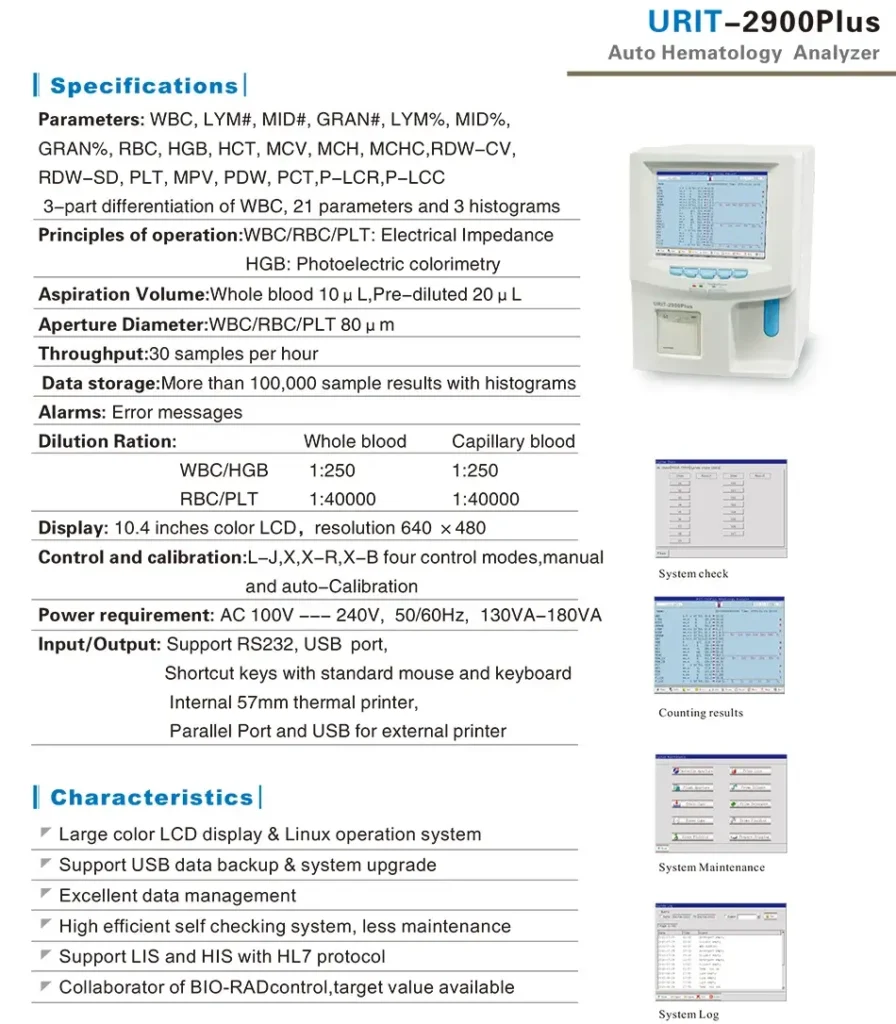Hematology Analyzer Model- URIT-2900 Plus Brand – URIT:
Hematology analyzer are medical devices used in clinical laboratories to perform automated blood tests, providing information about the cellular components of blood, such as red blood cells, white blood cells, and platelets. These analyzers use various methods, including impedance, flow cytometry, and spectrophotometry, to analyze and quantify blood cell parameters.
Characteristics:
1. 13 pre-defined animal species + 3 programmable animals
2. Large color LCD display & Linux operation system
3. Support USB data backup & system upgrade
4. Excellent data management with mouse and keyboard
5. Calibration and quality control for each animal Support LIS and HIS with HL7 protocol
6. 13 pre-defined animal species + 3 programmable animals on request
7. 30 samples per hour, Automatic hematology analyzer for veterinary 3-part differentiation of WBC,21 parameters +3 histograms.

The URIT-2900 Plus is likely an upgraded version of its predecessor, possibly featuring improved capabilities, enhanced accuracy, additional parameters, and possibly more automation to streamline the analysis process. Specific features of the URIT-2900 Plus may include:
- Complete Blood Count (CBC): Hematology analyzers like the URIT-2900 Plus provide a CBC, which includes measurements of red blood cells (RBC), white blood cells (WBC), and platelets. It also provides values such as hemoglobin (Hb), hematocrit (HCT), mean corpuscular volume (MCV), mean corpuscular hemoglobin (MCH), and mean corpuscular hemoglobin concentration (MCHC).
- Differential White Blood Cell Count: This feature provides information about the various types of white blood cells present in the blood, including neutrophils, lymphocytes, monocytes, eosinophils, and basophils.
- Automation and Throughput: Hematology analyzers are designed to process a large number of blood samples efficiently. The URIT-2900 Plus might have an automated sample handling system, allowing for a high throughput of samples.
- Parameters: The URIT-2900 Plus could potentially measure additional parameters, such as red cell distribution width (RDW), mean platelet volume (MPV), and various white blood cell differentials.
- User Interface: Modern hematology analyzers often have user-friendly interfaces with touchscreens or graphical displays to make operation and result interpretation easier.
- Data Management: These analyzers typically offer data storage and management features, including the ability to save patient information, test results, and generate reports.
- Quality Control: Hematology analyzers come with built-in quality control features to ensure the accuracy and reliability of test results.
It’s important to note that the capabilities and features of a specific model may vary, and I do not have access to real-time or the latest information beyond September 2021. If you are considering purchasing or using the URIT-2900 Plus or any other medical device, I recommend consulting the manufacturer’s official documentation, specifications, and user guides for the most accurate and up-to-date information. Additionally, discussing with medical professionals or laboratory experts can provide insights into the performance and suitability of the device for your specific needs.

Other Attributes:
1. Place of Origin: China
2. Instrument classification: Class II
3. Type: Blood Analysis SYstem
4. Brand Name: URIT
5. Model Number: URIT-2900plus
6. Product Name: 3-part Hematology Analyzer
7. Aperture Diameter: WBC/RBC/PLT 80μm
8. Throughput: 30 samples per hour
9. Data Storage: More than 100,000 sample results with histograms
10. Alarms: Error messages
11. Display: 10.4 inches color LCD
12. Resolution: 640 480
13. Power Requirement: AC 100V — 240V, 50/60Hz, 130VA-180VA
14. Feature: Support USB data backup & system upg
15. Advantage: Excellent data management
Here are some key aspects of hematology analyzers:
Functionality: Hematology analyzers use various techniques, such as impedance, flow cytometry, and spectrophotometry, to analyze blood samples and determine various parameters related to blood cells.
Parameters Measured: A typical hematology analyzer provides a Complete Blood Count (CBC), which includes measurements of red blood cell count, hemoglobin concentration, hematocrit (the proportion of blood composed of red blood cells), white blood cell count, platelet count, mean corpuscular volume (average volume of red blood cells), mean corpuscular hemoglobin (average amount of hemoglobin per red blood cell), and mean corpuscular hemoglobin concentration (average concentration of hemoglobin in red blood cells).
Differential White Blood Cell Count: Many hematology analyzers can also differentiate between different types of white blood cells, providing information about the relative percentages of neutrophils, lymphocytes, monocytes, eosinophils, and basophils.
Automation: Hematology analyzers are automated instruments, which means they can process multiple samples quickly and efficiently. They often have mechanisms for sample handling, dilution, and analysis.
Sample Volume: Hematology analyzers require a small volume of blood from the patient, usually collected through a venous blood draw.
User Interface and Reporting: Modern analyzers typically feature user-friendly interfaces, often with touchscreens or graphical displays, allowing users to input patient data and receive detailed reports with the test results.
Quality Control: Hematology analyzers include quality control features to ensure the accuracy and reliability of test results. These controls help monitor the analyzer’s performance over time.
Maintenance: Regular maintenance is necessary to keep the analyzer in proper working condition. This includes cleaning, calibration, and troubleshooting.
Clinical Applications: Hematology analyzers are used in various clinical settings, including hospitals, clinics, research laboratories, and blood banks, to aid in diagnosing and monitoring a wide range of medical conditions related to blood.
It’s essential to consult the manufacturer’s official documentation or contact their customer support to get the most accurate and up-to-date information about the URIT-2900 Plus model and its specific features. Additionally, if you’re considering purchasing or using a hematology analyzer for a medical setting, it’s a good idea to engage with medical professionals or laboratory experts to ensure that the analyzer meets your specific requirements.

